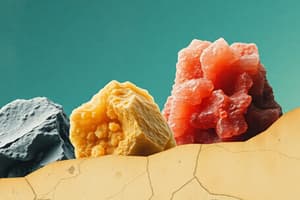Podcast
Questions and Answers
Which of the following statements accurately describes the difference between orthoclase and sanidine?
Which of the following statements accurately describes the difference between orthoclase and sanidine?
- Orthoclase and sanidine are both triclinic K-feldspars, but sanidine occurs in volcanic rocks, while orthoclase occurs in plutonic rocks. (correct)
- Orthoclase is monoclinic and occurs in plutonic rocks, while sanidine is triclinic and occurs in volcanic rocks.
- Orthoclase is triclinic and occurs in volcanic rocks, while sanidine is monoclinic and occurs in plutonic rocks.
- Orthoclase and sanidine are both monoclinic K-feldspars, but orthoclase occurs in volcanic rocks, while sanidine occurs in plutonic rocks.
Which of the following statements accurately describes the structural state of alkali feldspars?
Which of the following statements accurately describes the structural state of alkali feldspars?
- The structural state is dependent on the composition and the degree of ordering of the aluminum and silicon atoms.
- The structural state is dependent on the presence of potassium or sodium in the feldspar composition.
- The structural state is dependent on the temperature of crystallization and subsequent cooling history. (correct)
- The structural state is dependent on the degree of twinning and the optical properties of the feldspar.
Which of the following statements accurately describes the characteristics of adularia?
Which of the following statements accurately describes the characteristics of adularia?
- Adularia is a K-feldspar produced by low-temperature hydrothermal or authigenic processes, and it is structurally similar to microcline but without the cross-hatched twinning. (correct)
- Adularia is a Na-feldspar produced by low-temperature hydrothermal or authigenic processes, and it is structurally similar to sanidine but without twinning.
- Adularia is a K-feldspar produced by high-temperature magmatic processes, and it is structurally similar to orthoclase but with cross-hatched twinning.
- Adularia is a Na-feldspar produced by high-temperature hydrothermal or authigenic processes, and it is structurally similar to anorthoclase but with cross-hatched twinning.
Which of the following statements accurately describes the characteristics of anorthoclase?
Which of the following statements accurately describes the characteristics of anorthoclase?
Which of the following statements accurately describes the cooling history of volcanic feldspars?
Which of the following statements accurately describes the cooling history of volcanic feldspars?
Which of the following statements accurately describes the characteristics of microcline?
Which of the following statements accurately describes the characteristics of microcline?
What is the origin of the word 'feldspar'?
What is the origin of the word 'feldspar'?
What is the approximate percentage of feldspars in the Earth's crust?
What is the approximate percentage of feldspars in the Earth's crust?
What is the relationship between the ionic radii and charges of the K and Ca endmembers of feldspars?
What is the relationship between the ionic radii and charges of the K and Ca endmembers of feldspars?
What is the relationship between the compositional endmembers of feldspars?
What is the relationship between the compositional endmembers of feldspars?
What is the relationship between alkali feldspars and plagioclase feldspars?
What is the relationship between alkali feldspars and plagioclase feldspars?
What is the significance of the barium-containing feldspars celsian and hyalophane?
What is the significance of the barium-containing feldspars celsian and hyalophane?
What is the primary reason that plagioclase feldspars are the most common feldspar minerals?
What is the primary reason that plagioclase feldspars are the most common feldspar minerals?
Why is the substitution of ions in plagioclase feldspars a coupled process?
Why is the substitution of ions in plagioclase feldspars a coupled process?
What is the significance of the boundaries in the ternary diagram for feldspar mineral classification?
What is the significance of the boundaries in the ternary diagram for feldspar mineral classification?
How are alkali feldspars classified, in contrast to plagioclase feldspars?
How are alkali feldspars classified, in contrast to plagioclase feldspars?
What is the relationship between the composition of plagioclase feldspars and the type of igneous rock they are found in?
What is the relationship between the composition of plagioclase feldspars and the type of igneous rock they are found in?
What is the primary difference between the classification of plagioclase feldspars and alkali feldspars?
What is the primary difference between the classification of plagioclase feldspars and alkali feldspars?
Flashcards are hidden until you start studying




